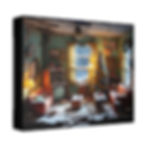
Welcome to Small World Miniatures, where we explore the intricate art of miniature creations and share inspiring examples to fuel your creativity. Today, we are delighted to present a stunning diorama: a miniature church inspired by the elegance of neoclassical and Rococo architecture, adorned with vibrant spring flowers. This exquisite model is a perfect blend of historical grandeur and the natural beauty of the spring season.
The Inspiration: Neoclassical and Rococo Elegance with Springtime Flourish
This miniature church diorama combines the timeless elegance of neoclassical design, the ornate charm of Rococo style, and the lively spirit of spring blossoms. The result is a breathtaking scene that captures the essence of historical opulence and natural beauty.
Historical Significance
Neoclassical architecture emerged in the mid-18th century, drawing inspiration from the classical art and culture of Ancient Greece and Rome. It is characterized by its grandeur, symmetry, and use of classical orders, exuding a timeless elegance. Rococo architecture, which developed slightly earlier, is known for its playful, ornate style, featuring intricate decorations, pastel colors, and whimsical motifs. The fusion of these styles in a miniature format brings together the best of both worlds, creating a visually stunning and historically rich piece.

Influential Artists and Architects
Architects like Robert Adam, a key figure in the neoclassical movement, are known for their harmonious and symmetrical designs. Rococo’s exuberant style was embodied by artists such as François de Cuvilliés and Jean-Honoré Fragonard, whose works are characterized by their intricate details and light-hearted elegance. These historical figures provide a wealth of inspiration for miniature enthusiasts aiming to recreate such opulence on a small scale.
Design and Elements
Structure and Materials
This diorama features a majestic church with a grand façade, adorned with columns, balustrades, and elaborate cornices typical of neoclassical architecture. The Rococo influence is evident in the ornate decorations, flowing lines, and pastel color palette. The church is surrounded by a lush garden, with flowers cascading from every ledge and window, creating a seamless blend of architecture and nature.
The model is crafted from high-quality materials, including fine wood for the structure, detailed resin for the decorative elements, and realistic artificial flowers. The meticulous craftsmanship ensures that each element, from the delicate columns to the vibrant blossoms, is rendered with stunning accuracy.
Colors and Aesthetics
The color palette is a delightful mix of soft pastels and vibrant hues. The church itself is painted in a soothing light cream, complemented by the pinks, purples, yellows, and greens of the surrounding flowers. This harmonious blend of colors enhances the overall aesthetic, creating a scene that is both elegant and full of life.

Similar Architectural Examples
For those inspired by this enchanting diorama, several architectural styles and designs share similar characteristics:
• Palladian Architecture: Named after the Venetian architect Andrea Palladio, this style emphasizes symmetry, perspective, and classical temple elements, similar to neoclassical design.
• Baroque Architecture: Known for its grandeur and exuberance, Baroque architecture often features dramatic use of light and shadow, bold decorations, and intricate details.
• Georgian Architecture: Popular in the 18th century, Georgian architecture is characterized by its proportion and balance, with classical elements similar to those seen in neoclassical design.
Tips for Aspiring Miniature Enthusiasts
Creating a miniature model as detailed and enchanting as this neoclassical Rococo church requires patience, creativity, and a keen eye for detail. Here are some tips to help you achieve similar results in your miniature projects:
1. Invest in High-Quality Materials: Use fine wood, detailed resin, and realistic artificial flowers to ensure your model looks authentic and stands the test of time.
2. Plan Your Design Carefully: Sketch your ideas and create a detailed blueprint before starting construction. This will help you visualize the final product and make necessary adjustments.
3. Focus on Intricate Details: Pay close attention to small elements like columns, balustrades, and floral arrangements. These details bring your miniature to life.
4. Experiment with Color: Choose a harmonious color palette that reflects the theme of your model. Mixing soft pastels with vibrant hues can create a visually pleasing and cohesive look.
5. Incorporate Natural Elements: Adding realistic flowers, plants, and other natural touches can enhance the charm and authenticity of your diorama.
6. Learn from the Masters: Study the work of historical architects and artists who inspire you. Analyzing their techniques and styles can provide valuable insights for your own creations.
The neoclassical Rococo church diorama featured today is a stunning example of the beauty and creativity that miniature enthusiasts can achieve. By blending historical architectural elements with the vibrant spirit of spring, this model captures the imagination and transports viewers to a world of elegance and charm. We hope this inspires you to embark on your own miniature adventures and create enchanting scenes that tell your unique story.
#MiniatureDiorama #NeoclassicalArchitecture #RococoStyle #SpringMiniatures #MiniatureArt #ElegantMiniatures #HistoricalArchitecture #ArtInMiniature #MiniatureInspiration #SmallWorldMiniatures































